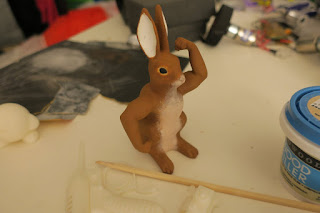After seeing the Battlebot Bombshell perform on television with it's modular weapons I knew I had to do that myself. The main goals were to create a modular robot that had an over-undercutter.
 |
Bombshell with the over-undercutter at left. Photo from BattlePark2.0.
|
So I created Dinner Time, a modular three pound combat robot, complete with three different attachments.
 |
| Horizontal undercutter. |
 |
| Vertical drum. |
 |
| Over undercutter. |
 |
| Fabricated. |
I wanted an undercutter for general use, a vertical designed to peel up wedges that the undercutter has trouble with, and an over undercutter designed to outreach other horizontal spinners.
The interface is a dovetail joint bound together with two aluminum posts. Together they provide a rigid connection difficult to rip apart in all directions, while providing easy removal when purposely disassembled.
 |
| Detail of the assembled dovetail joint. |
 |
| Detail of the connection disassembled, showing aluminum posts. |
Since all the weapons were brushless hub motors, there was no mechanical linkage to design. Only three wires needed to be passed through. However, since the connector was buried inside the frame of the robot, the cover needed to be removed to change attachments. It was a roughly two minute process.
The design of the undercutter was reused from previous Margin of Safety 3, using the spline hub motor holder. The body of the undercutter and the over-undercutter were printed by
Jamison Go.
 |
| Motor assembly with hub removed. |
Since the blade thickness was increased in this robot, I needed to make a spacer for things to compress right. No big deal.
 |
| Undercutter weapon hub assembly. |
 |
| Blade retaining washer removed, showing spacer. |
 |
| Blade removed. |
The vertical weapon took a lot of inspiration from the robot "Weta, God of Ugly Things". The small points of contact of the front support is to maximize ground pressure for pickup up wide wedges.
 |
| Robot with vertical attachment. |
The weapon makes liberal use of plastite screws to hold the front supports on. A long shoulder screw holds the weapon together axially.
 |
| Plastite screws, inferior only to mold-in inserts, if even. |
 |
| The axial stackup. The two bearings sit directly below the weapon, leaving the motor rotor cantilevered. |
This weapon attachment has some very prominent weaknesses. It cannot take side impacts on the front supports; the screws will pull out of the plastic. Vertical weapons of sufficient range can hit the cantilevered section of the hub motor. Due to the modular design, though, each weapon is allowed to specialize in certain types of opponents, making it acceptable to overlook these weaknesses.
The over-undercutter was very interesting to design. It uses the same hub motor design as the undercutter, extended to put the weapon disk in front of the frame, with an aluminum "tongue" to prop it up above the ground.
 |
| Side profile showing tongue. |
 |
| Inverted with over-undercutter, showing placement of tongue. |
The tongue was made of 7075 aluminum, which shouldn't be used for spring applications but the number of load cycles here is very low. The sides and front of the tongue was smoothed to avoid opposing undercutters from catching the sides of it. Should the tongue be knocked off the blade will hit the ground.
The springiness of the tongue made every use exciting.
The over-undercutter received mild damage from running it against certain opponents.
 |
| A hole in the side, no big deal. |
Finally the thickness of the weapon interface allowed using larger diameter motors, so I switched to the
Botkits 22mm motors, which are substantially more robust than the previous silver sparks and more tolerant of overvolting. The triple motor controller from Margin of Safety 3 was also reused.
This robot won Motorama 2017 with a record of 9-1.
 |
| Glamour shot. |
 |
| All the pieces. |

































































